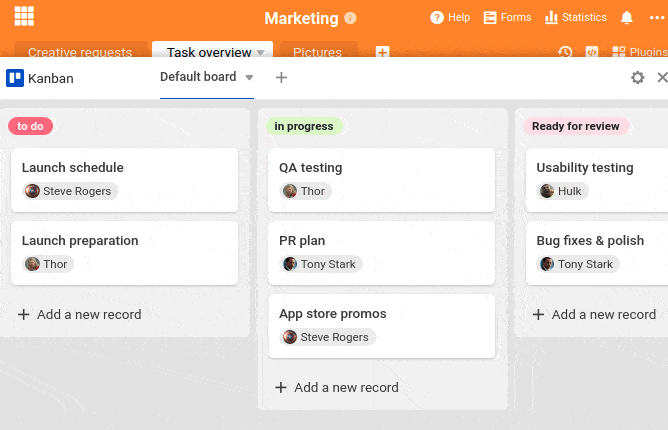Promoting brand awareness, communicating important information and leading projects to success - these are three of the most important goals for a marketing plan. It is the basis for all successful marketing activities. Those who use digital tools to create a marketing plan template have a particular advantage.
In this article you will learn what a marketing plan is, when you need one for your business and how to create a marketing plan as a digital template.
What is a marketing plan?
A marketing plan is the basis for any goal-oriented marketing planning. As a document containing a list of all current and future marketing activities, including goals and contexts, it is an important guide for your marketing department. A marketing plan helps your teams to plan and implement measures in a structured way. It also serves to identify and minimise possible risks at an early stage and to prevent wrong decisions. Working with a good marketing plan also gives you the opportunity to define exactly the right courses of action for the respective project and to tailor them precisely to the market and market needs. A digital marketing plan template ensures a transparent and seamless exchange of information.

Marketing Plan Template © ivanko80 / adobe stock
When does a marketing plan and digital template make sense?
Every marketing activity is about achieving goals. Whether social media campaigns, annual planning or product marketing - every plan pursues a specific goal. To achieve this, many different action steps are necessary, which in turn all have to be planned, implemented and documented. To ensure that your marketing team does not lose track, it makes sense to work with a digital marketing plan template. This helps you to structure measures, prioritise work steps effectively and define milestones within the project.
A marketing plan helps not only to set the time frame for marketing planning, but also to stick to it. Just think of a marketing plan as a detailed action plan in which you document all measures, timelines and responsibilities in order to have an up-to-date overview of your projects at all times. The larger a campaign is, the more sensible it is to rely on a marketing plan as a digital template.
How to create a professional marketing plan
For a marketing plan to really work, a digital template is the most important basic requirement. These five steps can help you create your marketing plan.
1. analyse the current situation and define a strategy
Before you can define the appropriate measures for your marketing projects, it is important to look at where you and your company currently stand. Get an overview of the status quo of your marketing department:
- What are the strengths and where are the weaknesses?
- What opportunities does the market offer and what are the possible risks?
- How is the marketing department set up (staff, resources, capacities)?
- Where are we now and where do we want to go - what is our vision?
Once you have defined the current state, the next step in creating the marketing plan and template is to determine which goals you would like to achieve in the near, medium and distant future.
2. formulate your vision and your objective
You now know where your marketing department stands. Now it is a question of finding out in which direction your marketing measures should move: What is your objective? Once you have this very clearly defined, you can write down the starting point and the end point of your marketing plan in the template.
3. take a look at your target group
Before you start with the concrete planning of the necessary work steps to achieve the goal, an analysis of your target group is recommended:
- Who do you want to address with your marketing activities?
- What characteristics make up your target group?
- How do you attract and keep the interest of your target group (also in the long term)?
These aspects are an essential part of a marketing plan template, as the target group is the all-important factor in determining whether a campaign is top or flop.
4. fill the marketing plan with your strategies and measures.
Once the target group has been analysed, you can get started and fill your marketing plan template with all strategies and measures to achieve the goal. It can be helpful to consider the following aspects and note them down as the project context:
- Analysis/comparison with the competition
- Your USP/Unique selling proposition
- Possible distribution and communication channels
- Planned marketing tools
- available budget
- Interim goals and milestones
5. implementation, controlling and success analysis
A detailed marketing plan not only contains an overview of all measures of a project, but also the documentation of the course of the project. This consolidates a structured approach and also makes it possible to keep an eye on the progress and profitability of a campaign at all times. You can see immediately if a project is moving in the wrong direction and can take countermeasures at an early stage.
In this context, it is also useful to note the aspect of analytical tools in your marketing plan template. This helps you to filter out relevant key figures for your goals and thus draw important conclusions about the success of the project. Marketing tools and analysis tools are therefore part of every marketing plan. In addition, you can see in black and white which measures were successful and which were less successful. This experience can be very valuable for subsequent projects.
Marketing planning with digital tools
Creating a marketing plan as a template on paper is one possibility - but it is not necessarily goal-oriented. Or can you imagine that everyone in the marketing team works with just one piece of paper on which they write down all the data about the project, touch it up, cross it out, etc.? It's much easier, faster and more transparent with digital tools for marketing planning. Whether Hubspot, SeaTable or Asana - digital tools like these help you to bring together all project data, keep an eye on the control of time and content and present everything clearly for everyone involved in the project.
A digital template for your marketing plan ensures that you can simplify your work processes and reduce the workload. This leads to more effectiveness and provides your team with valuable time for what really counts: creative work. Because time-consuming and unplanned tasks are not welcome in any campaign. With a digital tool like SeaTable, you therefore have the opportunity to use your marketing plan for process optimisation, for example, and thus enable your entire team to work more efficiently and creatively. And these are not the only advantages:
- As a digital tool, SeaTable makes it possible to automate recurring activities across all project phases. This saves valuable time.
- Thanks to clear and detailed planning, the tool helps to organise projects transparently and to control them in terms of time and content.
- As a central system containing all information, a SeaTable marketing plan template ensures that every team member knows the goals, measures and deadlines of a project and can thus allocate their work efficiently. This optimises workflows and promotes truly effective work.
- Whether texts, images or date values - SeaTable can work with any kind of information. So for your marketing plan template, you also have the option of integrating other applications and tools into SeaTable - all clearly in one place.

© SeaTable
Get started straight away with your individual marketing plan template
Are you worried that creating a marketing plan template will take up valuable time that you would rather use differently? That doesn't have to be the case. Whether it's a marketing campaign, social media strategy or editorial plan, competitor analysis, customer feedback or NPS questionnaire - for every marketing plan, digital tools like SeaTable have ready-made templates that contain all the important aspects and can be flexibly adapted to your needs at the same time. So you can get started with your marketing planning right away.
Image source Cover image: © hakinmhan/Adobe Stock

